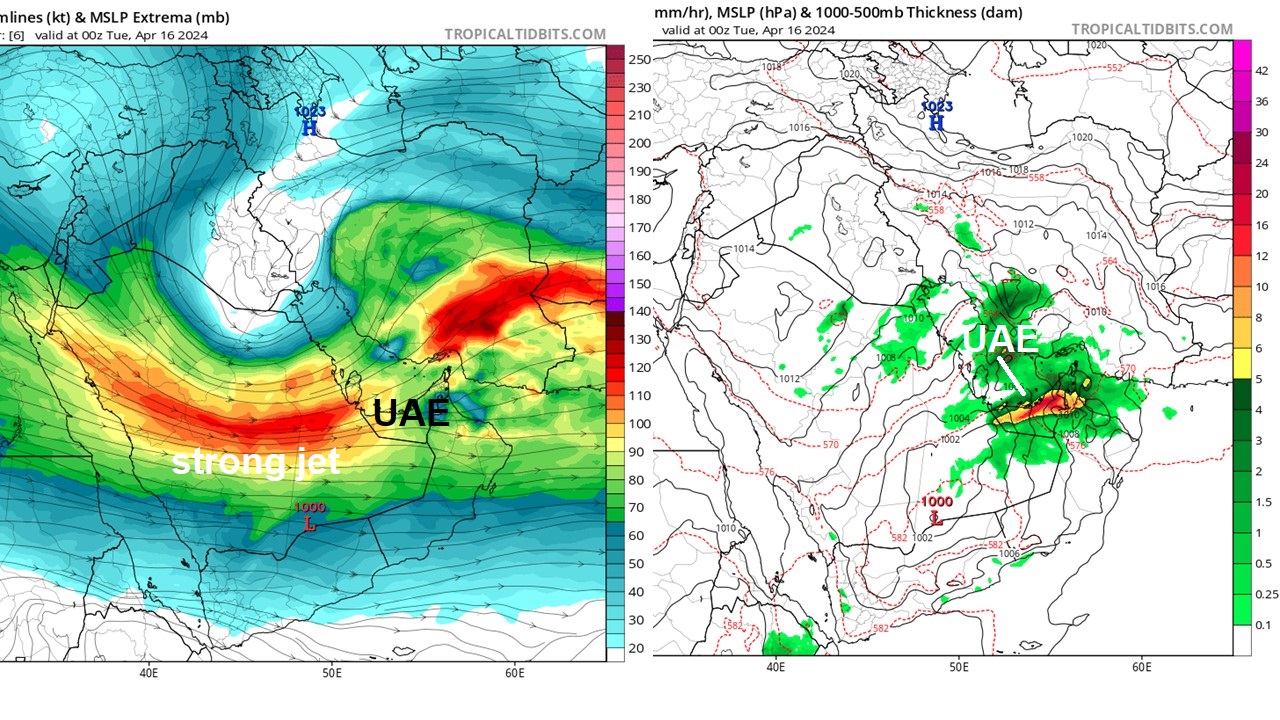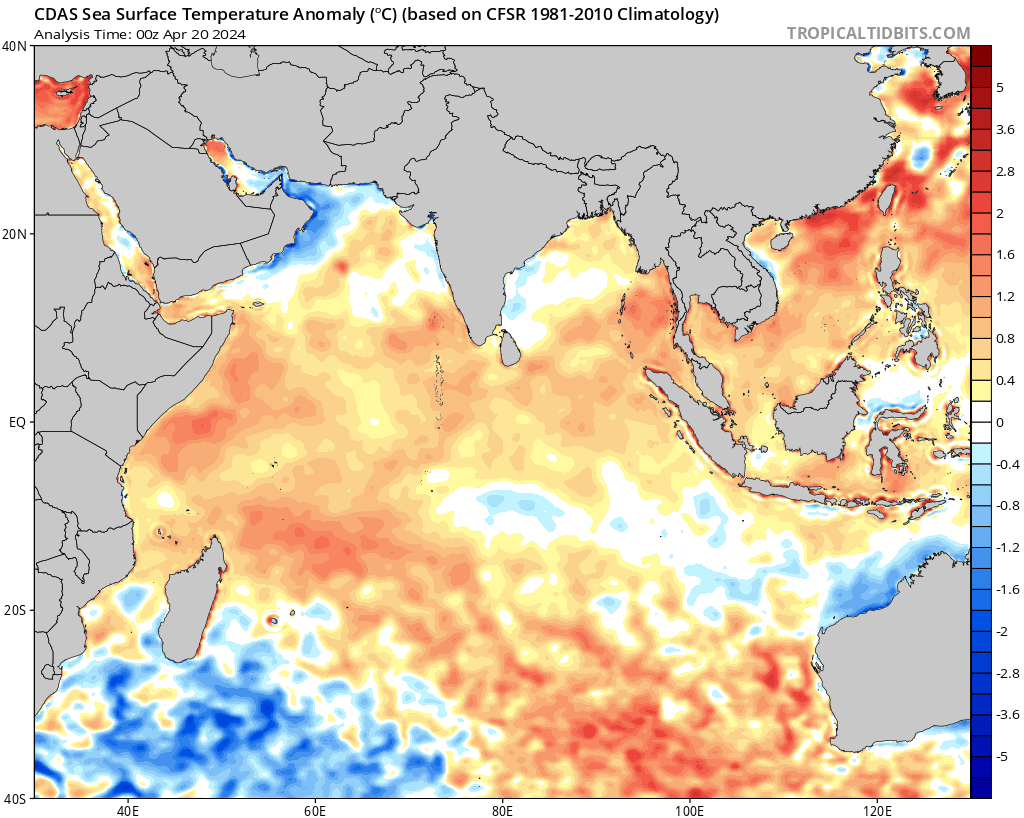
The flooding in the Middle East desert city of Dubai earlier in the week followed record-breaking rainfall. It doesn't rain very often here like other desert areas, but like the deadly floods in Libya last year showed, these rain events are likely becoming more extreme due to global warming.
Dubai continues a massive clean-up after severe thunderstorms swept across parts of the Arabian Peninsula Monday evening into Tuesday, causing extensive flooding in the glitzy high-rise desert city. Deserts are defined by their aridity, and rainfall is rare. Sometimes, however, uncommon meteorological circumstances line up perfectly, causing extreme flooding. However, these flooding events are likely to be exacerbated by climate change.
By the end of Tuesday, more than 142mm (5.59 inches) fell over Dubai – home to more than three million people. Close to 127mm (5 inches) of rain fell at Dubai International Airport, where about 76mm (3 inches) of rain is normal in an entire year. For the UAE it was the highest rainfall in a 24-hour period since records began 75 years ago. Neighbouring Oman received around 230mm (9 inches) of rain between Sunday and Wednesday. The average rainfall in the capital, Muscat is about 100mm (4 inches) per year.
The flooding was exacerbated by inadequate drainage, as Dubai hasn’t built drainage infrastructure to cope with large volumes of rainfall, given the city rarely sees rain.
Rains are rare in the United Arab Emirates, where the city of Dubai is, and elsewhere on the Arabian Peninsula, which is typically known for its dry desert climate. Summer air temperatures can soar above 50 degrees Celsius.
Following Tuesday's events, questions were raised about whether cloud seeding, a process that the UAE frequently conducts, could have caused the heavy rains.
The UAE does carry out cloud-seeding, a process of manipulating clouds to increase rainfall by using planes and ground-based cannons to shoot particles into clouds making more nuclei, attracting moisture and when enough droplets merge, they become heavy and fall to Earth as rain or snow. But the UAE government agency responsible denied conducting any such operations before the storm.
Heavy rainfall experienced by UAE and Oman could not be produced by cloud-seeding alone, the cumulonimbus clouds that produced the intense rainfall, frequent lightning and strong winds grew above 40,000 feet in height within a very short space of time. Something that can’t be done by cloud-seeding, which is usually done to thinner stratiform clouds to produce light or moderate rain. Besides, weather models forecast the extreme rainfall well in advance.

The extreme rainfall was instead likely due to a normal low pressure system that was exacerbated by climate change and El Nino. Anomalous warmth in the nearby western Indian Ocean and current El Nino forcing on the atmosphere likely enhanced the jet stream above the Arabia Peninsula earlier in the week – which aided in allowing waves of storms to develop and organise into a Mesoscale Convective System (MCS) – which swept east across the Arabian Peninsula Monday evening.

A similar event occurred in January 2020, with heavy rainfall across southern Iran and part of the UAE between the 9th and 12th triggering flash-flooding and leading to the loss of 2 lives. Dubai saw flooded roads which caused major traffic disruption. Flights were also disrupted at Dubai International Airport.
The world has also seen other unusual extreme rainfall events in normally arid desert areas that have caused devastating and deadly floods in recent years. Again, these events were likely exacerbated by climate-change.
In Libya last September, 5,300 lives were lost in the eastern city of Derna as massive floods swept through triggered by extremely heavy rainfall of around 400 mm brought by Storm Daniel on 10 September. Rivers and streams quickly filled, in particular in the Wadi Darnah river basin that runs through the city of Derna to the Mediterranean Sea. Two dams in the Wadi Dernah basin reportedly failed: the Al-Wadi Derna dam upstream, and the Derna Dam closer to the outskirts of the city. A study by climate scientists of the World Weather Attribution group said that climate change made the Libya flooding catastrophe 50 times more likely. Storm Daniel lingered over the Mediterranean which allowed it to absorb additional energy from sea temperatures that were two to three degrees above the September average. This extra warmth increased the air’s moisture-holding capacity. For every extra 1 degree of warming, the air can hold 7% more moisture.
Rare weather events often mean that not only did the atmosphere look incredibly different than normal, but also that a series of strange events coincided with each other. In March 2015 unusual ocean and atmospheric conditions produced many years’ worth of rainfall in a 48 h period over northern Chile’s Atacama Desert, one of Earth’s driest regions, resulting in catastrophic flooding. The floods affected an approximately 80,000 km2 area of the Atacama Desert. The toll of the flooding included 31 deaths, 16 people disappeared, 30,000 people displaced, as well as widespread damage to homes, roads, bridges, and railroads. Usually, a persistent high pressure system camps out over west-central South America, keeping low-pressure systems from moving north over the Atacama Desert bringing rain. However, during the end of March 2015, the blocking high pressure weakened and drifted east. allowing low pressure to meandered much farther north than usual, northwest winds drawn into the low picked up tropical moisture over an area of ocean that had warmed rapidly (over 2°C in some locations) during the prior week.
Deserts have always seen occasional rain events that lead to flash-flooding, but with a warming world and the atmosphere able to hold more moisture, these rainfall events are likely to become more extreme, with infrastructure in these areas not built to cope with high rainfall in a short space of time, major disruption, damage to property and risk to life will be inevitable.